Energy Market Overview: June marked by record price drops and peaks in renewable energy production
- Prices in the Baltic States have fallen for the fourth consecutive month. In June, the average wholesale price remained at 4.1 cents per kilowatt-hour.
- As of the end of June 2025, there had been a total of 674 hours in the Estonian price area when the price was 0.5 cents or even lower.
- The Estlink 2 outage increased prices by an average of 2.2 cents per kilowatt-hour between January and June.
- Batteries are emerging as a source of revenue in the Baltic electricity market. For example, a 1 MW / 2 MWh battery could have earned approximately €6,800 on the day-ahead market in June, but more than €50,000 when participating in all markets.
Electricity prices in the Baltics fall for the fourth consecutive month
In June, electricity prices fell by 39% compared to May, reaching 4.1 cents per kilowatt-hour (or 41 euros per megawatt-hour). The main drivers of the price drop were a substantial increase in wind power generation in the Baltics (+39% compared to May, +129% year-on-year), an unexpected rise in hydropower generation (+31% compared to May, +134% year-on-year) and record-low levels of fossil fuel-based electricity production (-59% compared to May).
Although solar generation remained at the same level as in May, it still accounted for a significant share of total consumption in the Baltic States.
Despite low price levels, June was one of the most volatile months in the Baltics in recent years, with price fluctuations averaging 113% and hourly prices ranging on average from -0.5 to 8.7 cents per kilowatt-hour. The main factor behind the fluctuations was the impact of solar power generation: when the sun sets, more expensive fossil fuel-based power plants (primarily gas-fired power plants in Latvia and Lithuania) are brought online, causing prices to spike.
The volatility was mitigated by the return of the Estlink 2 interconnection to the market on 19 June, which enabled the import of more affordable nuclear and hydropower from the Nordics to the region, reducing the need to start up costlier plants.
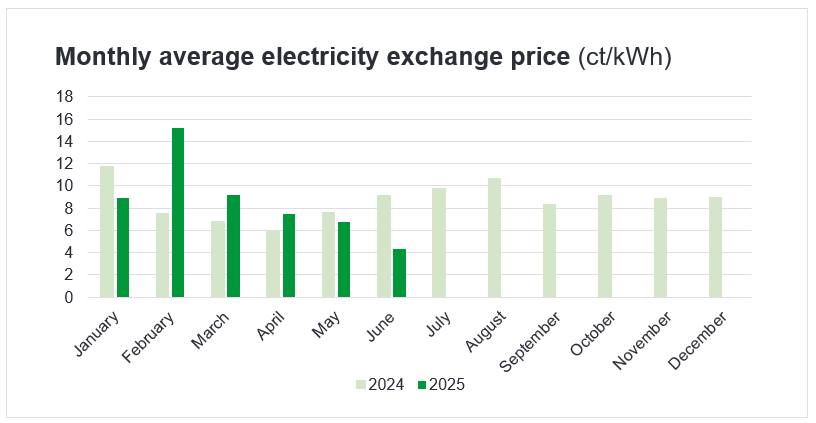
June set new records in price dynamics
In addition to record levels of electricity generation, June also set new records in electricity prices. Thanks to favourable solar, wind and hydropower generation entering the market, there were an increasing number of hours when the price remained below 0.5 cents per kilowatt-hour or even dropped to zero or negative values.
As of the end of June 2025, electricity prices in the Estonian price area were at or below 0.5 cents per kilowatt-hour for a total of 674 hours. Last year, there were 720 such hours in total, meaning that in just six months, nearly 94% of the previous year’s total has already been reached. It is noteworthy that nearly half of the hours with prices at or below 0.5 cents per kilowatt-hour in 2025 occurred in June, totalling 290 instances.
These low prices occurred mainly around midday (between 10:00 and 16:00) when solar generation is at its peak. Similar dynamics, with strong solar and wind generation keeping daytime prices mostly close to zero, are also expected in July and August. However, during the evening hours, prices depend more on gas-fired plants and electricity exports from the Nordic countries via the Lithuania–Sweden and Estonia–Finland interconnections.
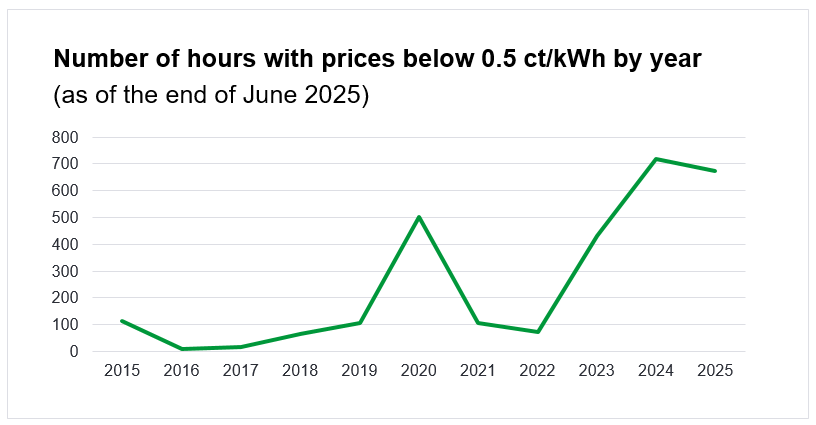
This June also differed from previous years in terms of hourly prices. Comparing the average price per hour with the monthly average reveals that midday prices were significantly lower, while morning and evening peak hours were noticeably higher. Between 11:00 and 16:00, prices were nearly 65% below the monthly average, while during peak hours from 19:00 to 21:00, they were up to 103% higher.
The market is becoming increasingly extreme in terms of price fluctuations, with very low or very high prices becoming more common. The disappearance of affordable daytime prices during the summer months is not expected, at least until storage solutions (such as batteries) become more widely adopted. At the same time, the return of Estlink 2 to the market may help mitigate expensive evening peak hours.
The graph below illustrates how hourly price peaks and troughs have grown longer over the years.
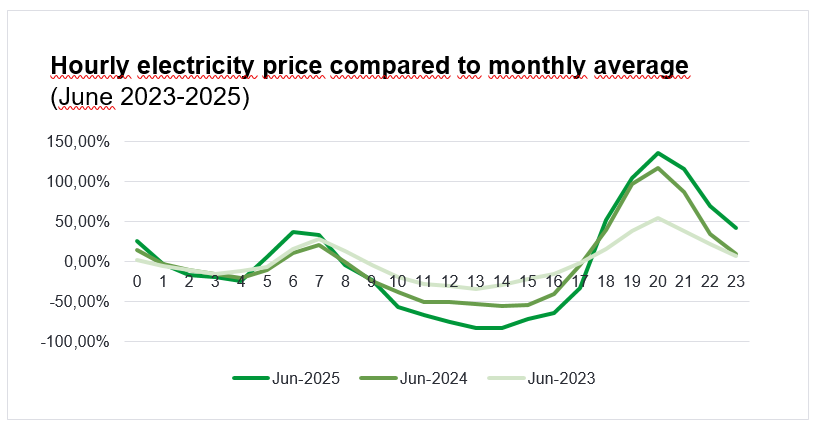
Estlink 2 outage raised prices in the Baltics by an average of 2.2 cents per kilowatt-hour
Since electricity prices in the Baltics fluctuate within the same price range (±0.5 cents per kilowatt-hour) more than 90% of the time, production in the region can be viewed as a single system. For example, electricity prices in the Baltics are influenced by the Estlink 2 interconnection, Latvian hydropower generation and the strong renewable energy output of Lithuania.
The 700 MW NordBalt (Lithuania–Sweden) and 1,000 MW Estlink 1 and 2 (Estonia–Finland) interconnections are particularly important for the Baltics, as they enable the import of affordable renewable and nuclear energy from the Nordic countries. When the 650 MW Estlink 2 interconnection went offline at the end of last year, the Baltics lost nearly 40% of their import capacity from the Nordic countries. As a result, evening prices rose in particular, as expensive oil shale power plants in Estonia and gas-fired plants mainly located in Latvia and Lithuania had to be brought online to meet local demand.
According to the internal forecasts of Eesti Energia, the absence of Estlink 2 from January to June raised the average electricity price in the region by 2.2 cents per kilowatt-hour. The greatest impact on prices was initially expected during the summer months, but increased Latvian hydroelectric generation in June helped mitigate the effect on average price levels.
If the interconnection had not been restored, the impact in July and August was forecast to be 3 to 4 cents per kilowatt-hour. This would have been due to the anticipated decrease in Latvian hydropower production over the coming months, which would have removed the price-reducing effect.

Batteries are entering the Baltic market in increasing volumes
In recent years, there has been growing interest in batteries that can participate in the market like any other electricity generation unit – supplying electricity to the grid and taking part in balancing markets and frequency regulation. Batteries can also be used to generate revenue: one of the most common approaches is to charge the battery during off-peak hours when prices are low and sell the stored energy back to the grid at higher prices during peak hours.
According to the models of Eesti Energia, a 1 MW / 2 MWh battery would have earned approximately €6,800 on the day-ahead market in June, assuming two cycles per day and 100% efficiency. If the same battery had participated in all energy markets (aFRR, mFRR, FCR and the day-ahead market) in June, it could have earned up to €55,000 using the physical trading strategies of Eesti Energia – more than 8.1 times the revenue from the day-ahead market alone.
This outcome is made possible by the flexibility service of Eesti Energia, which enables access to all energy markets. Flexible energy management also makes renewable energy assets manageable and enables renewable energy balancing and frequency services trading.
The graph below shows how revenue from the flexibility service of Eesti Energia was distributed across different markets in June: the reserve market, frequency market, day-ahead market and intraday market.
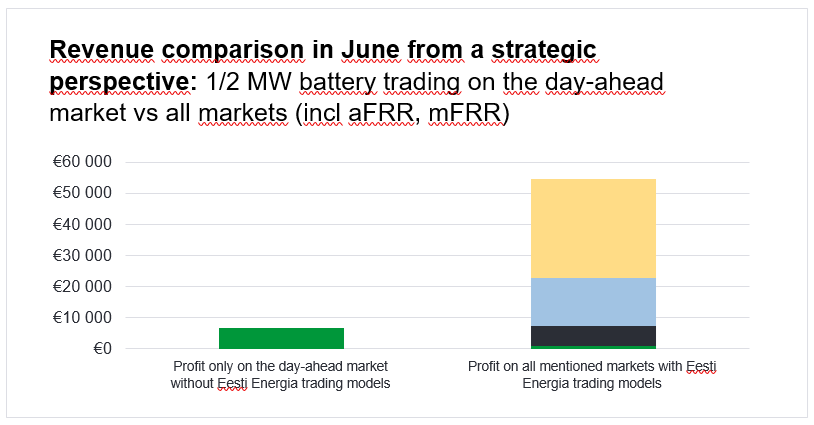
NB! This is a model-based estimate – actual outcomes depend on market conditions and regulatory constraints.
Natural gas prices fluctuated due to geopolitical and regulatory factors
In June, natural gas prices were primarily affected by the geopolitical situation in the Middle East, particularly tensions between Israel and Iran. During the first 20 days of the month, the price of natural gas (TTF) rose by more than 20% as market participants feared that Iran might close the Strait of Hormuz, an important supply route for liquefied natural gas from major exporters such as Qatar and the United Arab Emirates.
On 23 June, clearer signs of a possible ceasefire began to emerge, prompting a decline in natural gas prices. The price drop was further supported by the decision of the European Union to ease gas storage requirements, allowing market participants to spread their otherwise mandatory summer purchases over a longer period.
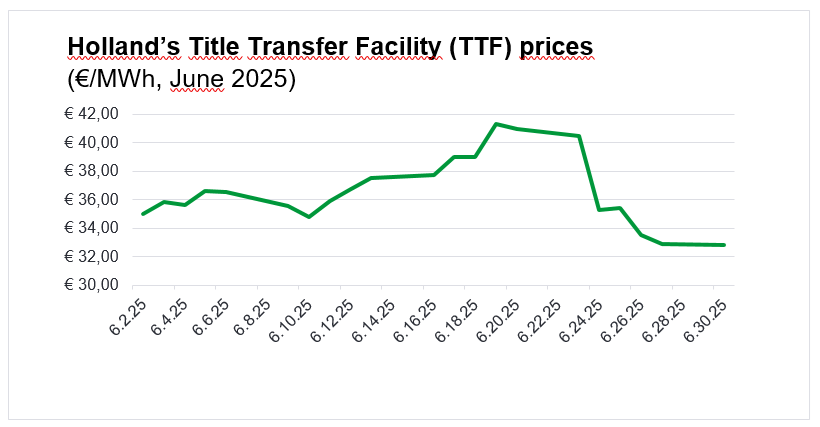
Carbon allowance prices reflected market developments
At the beginning of June, carbon allowance (EUA) prices rose to €76 per tonne, primarily due to the increase in natural gas prices. The rise in natural gas prices led market participants to expect that more coal-fired power plants would be brought online, thereby increasing demand for carbon allowances.
Speculative purchases rapidly pushed up allowance prices, but this was followed by a decline in the second half of June. The primary reason for the drop was strong renewable energy production across Europe, which reduced the need for fossil fuel-based electricity generation and, consequently, the demand for allowances.
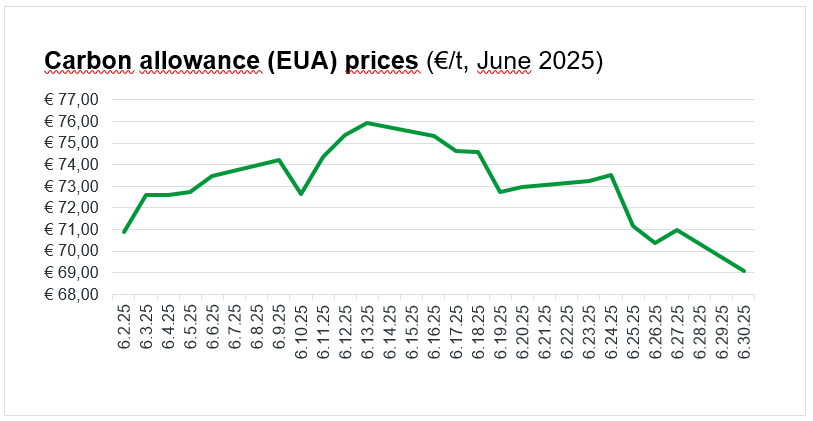
How to access energy markets through Enefit?
Enefit is a leading trading partner for flexible renewable energy balancing and frequency services in the Baltics. We operate in both the automatic (aFRR) and manual (mFRR) frequency restoration reserve markets across all Baltic countries. With more than 600 MW of qualified solar and wind capacity and a portfolio of nearly 1,500 MW of dispatchable renewable energy, Enefit has the capability to deliver top-quality, reliable and scalable energy services.
The trading and optimisation solutions of Enefit use the latest algorithms and automated strategies, enabling participation across all electricity-related markets. Enefit has also become a pioneer in battery storage optimisation and trading throughout the Baltics, being the first in the region to implement battery-based frequency containment reserve (FCR) solutions and develop inter-market optimisation programmes.
If you are looking for professional and reliable access to energy markets – whether for energy trading, automation or integrating your energy assets – Enefit has the experience and capabilities to assist you.
Karl Joosep Randveer, Energy Trading Analyst at Eesti Energia
The market overview has been compiled by Eesti Energia according to the best current knowledge. The information provided is based on public information. The market overview is presented as informative material and not as a promise, proposal or official forecast by Eesti Energia. Due to rapid changes in the regulation of the electricity market, the market overview or the information contained in it is not final and may not correspond to future situations. Eesti Energia is not liable for any costs or damages that may arise in connection with the use of the information provided.
Would you like to stay informed about the energy market? Join our monthly energy market overview newsletter on LinkedIn!